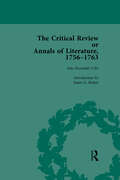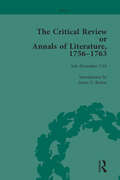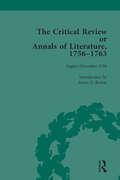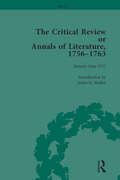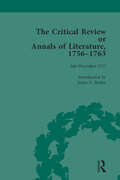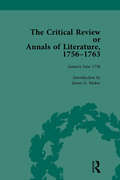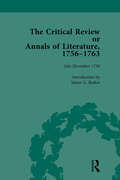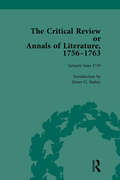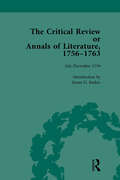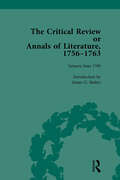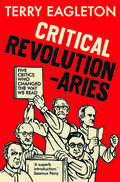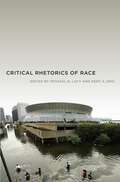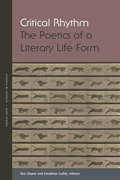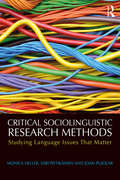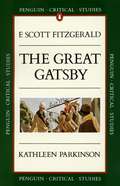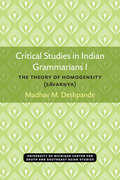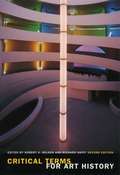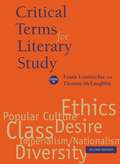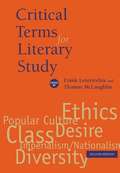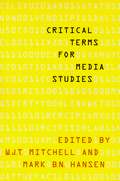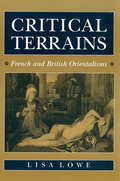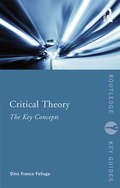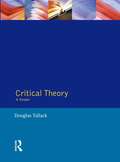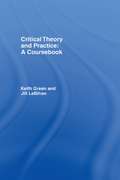- Table View
- List View
The Critical Review or Annals of Literature, 1756-1763 Vol 14
by James G BaskerThe "Critical Review" reflects the political, scientific and literary debate of the times. The journal was edited for its first seven years by Tobias Smollett and reflected the slashing, combative style and intellectual range of its editor. This 16-volume set reproduces this journal.
The Critical Review or Annals of Literature, 1756-1763 Vol 15
by James G BaskerThe "Critical Review" reflects the political, scientific and literary debate of the times. The journal was edited for its first seven years by Tobias Smollett and reflected the slashing, combative style and intellectual range of its editor. This 16-volume set reproduces this journal.
The Critical Review or Annals of Literature, 1756-1763 Vol 16
by James G BaskerThe "Critical Review" reflects the political, scientific and literary debate of the times. The journal was edited for its first seven years by Tobias Smollett and reflected the slashing, combative style and intellectual range of its editor. This 16-volume set reproduces this journal.
The Critical Review or Annals of Literature, 1756-1763 Vol 2
by James G BaskerThe "Critical Review" reflects the political, scientific and literary debate of the times. The journal was edited for its first seven years by Tobias Smollett and reflected the slashing, combative style and intellectual range of its editor. This 16-volume set reproduces this journal.
The Critical Review or Annals of Literature, 1756-1763 Vol 3
by James G BaskerThe "Critical Review" reflects the political, scientific and literary debate of the times. The journal was edited for its first seven years by Tobias Smollett and reflected the slashing, combative style and intellectual range of its editor. This 16-volume set reproduces this journal.
The Critical Review or Annals of Literature, 1756-1763 Vol 4
by James G BaskerThe "Critical Review" reflects the political, scientific and literary debate of the times. The journal was edited for its first seven years by Tobias Smollett and reflected the slashing, combative style and intellectual range of its editor. This 16-volume set reproduces this journal.
The Critical Review or Annals of Literature, 1756-1763 Vol 5
by James G BaskerThe "Critical Review" reflects the political, scientific and literary debate of the times. The journal was edited for its first seven years by Tobias Smollett and reflected the slashing, combative style and intellectual range of its editor. This 16-volume set reproduces this journal.
The Critical Review or Annals of Literature, 1756-1763 Vol 6
by James G BaskerThe "Critical Review" reflects the political, scientific and literary debate of the times. The journal was edited for its first seven years by Tobias Smollett and reflected the slashing, combative style and intellectual range of its editor. This 16-volume set reproduces this journal.
The Critical Review or Annals of Literature, 1756-1763 Vol 7
by James G BaskerThe "Critical Review" reflects the political, scientific and literary debate of the times. The journal was edited for its first seven years by Tobias Smollett and reflected the slashing, combative style and intellectual range of its editor. This 16-volume set reproduces this journal.
The Critical Review or Annals of Literature, 1756-1763 Vol 8
by James G BaskerThe "Critical Review" reflects the political, scientific and literary debate of the times. The journal was edited for its first seven years by Tobias Smollett and reflected the slashing, combative style and intellectual range of its editor. This 16-volume set reproduces this journal.
The Critical Review or Annals of Literature, 1756-1763 Vol 9
by James G BaskerThe "Critical Review" reflects the political, scientific and literary debate of the times. The journal was edited for its first seven years by Tobias Smollett and reflected the slashing, combative style and intellectual range of its editor. This 16-volume set reproduces this journal.
Critical Revolutionaries: Five Critics Who Changed the Way We Read
by Terry EagletonTerry Eagleton looks back across sixty years to an extraordinary critical milieu that transformed the study of literature Before the First World War, traditional literary scholarship was isolated from society at large. In the years following, a younger generation of critics came to the fore. Their work represented a reaction to the impoverishment of language in a commercial, utilitarian society increasingly under the sway of film, advertising, and the popular press. For them, literary criticism was a way of diagnosing social ills and had a vital moral function to perform. Terry Eagleton reflects on the lives and work of T. S. Eliot, I. A. Richards, William Empson, F. R. Leavis, and Raymond Williams, and explores a vital tradition of literary criticism that today is in danger of being neglected. These five critics rank among the most original and influential of modern times, and represent one of the most remarkable intellectual formations in twentieth-century Britain. This was the heyday of literary modernism, a period of change and experimentation—the bravura of which spurred on developments in critical theory.
Critical Rhetorics of Race (Critical Cultural Communication #12)
by Kent A. OnoAccording to many pundits and cultural commentators, the U.S. is enjoying a post-racial age, thanks in part to Barack Obama's rise to the presidency. This high gloss of optimism fails, however, to recognize that racism remains ever present and alive, spread by channels of media and circulated even in colloquial speech in ways that can be difficult to analyze. In this groundbreaking collection edited by Michael G. Lacy and Kent A. Ono, scholars seek to examine this complicated and contradictory terrain while moving the field of communication in a more intellectually productive direction. An outstanding group of contributors from a range of academic backgrounds challenges traditional definitions and applications of rhetoric. From the troubling media representations of black looters after Hurricane Katrina and rhetoric in news coverage about the Columbine and Virginia Tech massacres to cinematic representations of race in Crash, Blood Diamond, and Quentin Tarantino’s films, these essays reveal complex intersections and constructions of racialized bodies and discourses, critiquing race in innovative and exciting ways. Critical Rhetorics of Race seeks not only to understand and navigate a world fraught with racism, but to change it, one word at a time.
Critical Rhythm: The Poetics of a Literary Life Form (Verbal Arts: Studies in Poetics)
by Ben Glaser Jonathan Culler Derek Attridge Simon Jarvis David Nowell Smith Haun Saussy Tom Cable Natalie Gerber Virginia Jackson Ewan Jones Meredith Martin Yopie PrinsRhythm constitutes an untapped resource for understanding poetry, making legible a range of ways poetry affects us that cannot be parsed through the traditional resources of poetic theory.Rhythm has rich but also problematic roots in nineteenth-century notions of primitive, oral, communal, and sometimes racialized poetics. But there are reasons to understand and even embrace its seductions, including its resistance to lyrical voice and even identity. Pressing beyond poetry handbooks’ isolated descriptions of technique, the book asks what it means to think rhythm.
Critical Sociolinguistic Research Methods: Studying Language Issues That Matter
by Monica Heller Sari Pietikäinen Joan PujolarCritical Sociolinguistic Research Methods is a guide to conducting concrete ethnographic and discourse analytic research projects, written by top scholars for students and researchers in social science fields. Adopting a critical perspective focusing on the role of language in the construction of social difference and social inequality, the authors walk the reader through five key moments in the life of a research project: composing research questions, designing the project, doing fieldwork, performing data analysis and writing academic texts or otherwise engaging in conversation with different types of social actors about the project. These moments are illustrated by colour-coded examples from the authors’ experiences that help researchers and students follow the sequential stages of a project. Clear and highly applicable, with a detailed workbook full of practical tips and examples, this book is a great resource for graduate-level qualitative methods courses in linguistics and anthropology, as well as methods courses in the humanities and social sciences that focus on the role of language in research. It is a timely text for investigating language issues that matter and have consequences for people’s lives.
Critical Studies: The Great Gatsby
by Kathleen ParkinsonKathleen Parkinson places this brilliant and bitter satire on the moral failure of the Jazz Age firmly in the context of Scott Fitzgerald's life and times. She explores the intricate patterns of the novel, its chronology, locations, imagery and use of colour, and how these contribute to a seamless interplay of social comedy and symbolic landscape. She devotes a perceptive chapter to Fitzgerald's controversial portrayal of women and goes on to discuss how the central characters, Gatsby and Nick Carraway, embody and confront the dualism inherent in the American dream.
Critical Studies in Indian Grammarians I: The Theory of Homogeneity (SĀVARṆYA) (Michigan Series In South And Southeast Asian Languages And Linguistics)
by Madhav M. DeshpandeIn the historical study of the Indian grammarian tradition, a line of demarcation can often be drawn between the conformity of a system with the well-known grammar of Pāṇini and the explanatory effectiveness of that system. One element of Pāṇini’s grammar that scholars have sometimes struggled to bring across this line of demarcation is the theory of homogeneity, or savarṇa, which concerns the final consonants in Pāṇini’s reference catalog, as well as phonetic similarities between sounds. While modern Sanskrit scholars understand how to interpret and apply Pāṇini’s homogeneity, they still find it necessary to unravel the history of varying interpretations of the theory in subsequent grammars. Madhav Deshpande’s The Theory of Homogeneity provides a thorough account of the historical development of the theory. Proceeding first to study this conception in the Pāṇinian tradition, Deshpande then passes on to other grammatical systems. Deshpande gives attention not only to the definitions of homogeneity in these systems but also the implementation of the theory in those respective systems. Even where definitions are identical, the concept may be applied quite differently, in which cases Deshpande examines by considering the historical relationships among the various systems.
Critical Terms for Art History (2nd edition)
by Robert S. Nelson Richard Shiff"Art" has always been contested terrain, whether the object in question is a medieval tapestry or Duchamp's Fountain.
Critical Terms for Literary Study
by Lentricchia, Frank and McLaughlin, ThomasSince its publication in 1990, Critical Terms for Literary Study has become a landmark introduction to the work of literary theory—giving tens of thousands of students an unparalleled encounter with what it means to do theory and criticism. Significantly expanded, this new edition features six new chapters that confront, in different ways, the growing understanding of literary works as cultural practices. These six new chapters are "Popular Culture," "Diversity," "Imperialism/Nationalism," "Desire," "Ethics," and "Class," by John Fiske, Louis Menand, Seamus Deane, Judith Butler, Geoffrey Galt Harpham, and Daniel T. O'Hara, respectively. Each new essay adopts the approach that has won this book such widespread acclaim: each provides a concise history of a literary term, critically explores the issues and questions the term raises, and then puts theory into practice by showing the reading strategies the term permits. Exploring the concepts that shape the way we read, the essays combine to provide an extraordinary introduction to the work of literature and literary study, as the nation's most distinguished scholars put the tools of critical practice vividly to use.
Critical Terms for Literary Study (2nd edition)
by Frank Lentricchia Thomas MclaughlinAn expanded introduction to the work of literary theory covering the concepts that shape the way we read, with 28 essays written by a plethora of distinguished scholars.
Critical Terms for Media Studies
by W. J. T. Mitchell Mark HansenCommunications, philosophy, film and video, digital culture: media studies straddles an astounding array of fields and disciplines and produces a vocabulary that is in equal parts rigorous and intuitive. Critical Terms for Media Studiesdefines, and at times, redefines, what this new and hybrid area aims to do, illuminating the key concepts behind its liveliest debates and most dynamic topics. Part of a larger conversation that engages culture, technology, and politics, this exciting collection of essays explores our most critical language for dealing with the qualities and modes of contemporary media. Edited by two outstanding scholars in the field, W.J.T. Mitchell and Mark B.N. Hansen, the volume features works by a team of distinguished contributors.
Critical Terrains: French and British Orientalisms
by Lisa LoweExamining and historicizing the concept of "otherness" in both literature and criticism, Lisa Lowe explores representations of non-European cultures in British and French writings from the eighteenth through the twentieth century. Lowe traces the intersections of culture, class, and sexuality in Lady Mary Wortley Montagu’s Turkish Embassy Letters and Montesquieu’s Lettres persanes and discusses tropes of orientalism, racialism, and romanticism in Flaubert. She then turns to debates in Anglo-American and Indian criticism on Forster’s Passage to India and on the utopian projection of China in the poststructuralist theories of Julia Kristeva and Roland Barthes and in the journal Tel Quel.
Critical Theory: The Key Concepts (Routledge Key Guides)
by Dino Franco FellugaCritical Theory: The Key Concepts introduces over 300 widely-used terms, categories and ideas drawing upon well-established approaches like new historicism, postmodernism, psychoanalysis, Marxism, and narratology as well as many new critical theories of the last twenty years such as Actor-Network Theory, Global Studies, Critical Race Theory, and Speculative Realism. This book explains the key concepts at the heart of a wide range of influential theorists from Agamben to Žižek. Entries range from concise definitions to longer more explanatory essays and include terms such as: Aesthetics Desire Dissensus Dromocracy Hegemony Ideology Intersectionality Late Capitalism Performativity Race Suture Featuring cross-referencing throughout, a substantial bibliography and index, Critical Theory: The Key Concepts is an accessible and easy-to-use guide. This book is an invaluable introduction covering a wide range of subjects for anyone who is studying or has an interest in critical theory (past and present).
Critical Theory: A Reader
by Douglas TallackAn anthology of readings and extracts providing a comprehensive introduction to the main schools and positions of critical theory. The book is divided into five sections; structuralism and poststructuralism, psychoanalytical theory, Marxism, feminism, and post-foundational ethics and politics. It includes a general introduction covering the field of critical theory and identifies founding theorists and movements with a bibliography and notes.
Critical Theory and Practice: A Coursebook
by Keith Green Jill LeBihanCritical Teory and Practice answers lots of questions, but also stimulates new ones. Its tailor-made combination of survey, reader and workbook is ideal for the beginning - perhaps even bewildered - student of literary theory. The work is divided into seven chapters, each of which contains guiding commentary, examples from literary and critical works, and a variety of exercises to provoke and engage you. Each chapter includes a glossary and annotated selection of suggested further reading. There is also a full bibliography. The authors cover the key issues and debates of literary theory, including: * Language, Linguistics and Literature * Structures of Literature * Literature and History * Subjectivity, Psychoanalysis and Criticism * Reading, Writing and Reception * Women, Literature and Criticism * Literature, Criticism and Cultural Identity Critical Theory and Practice is an refreshingly clear, up-to-date and eminently readable introduction to the subject. It not only guides you through the terminology and gives you a selection of the key passages to read, it also helps you engage with the theory and apply it in practice.
